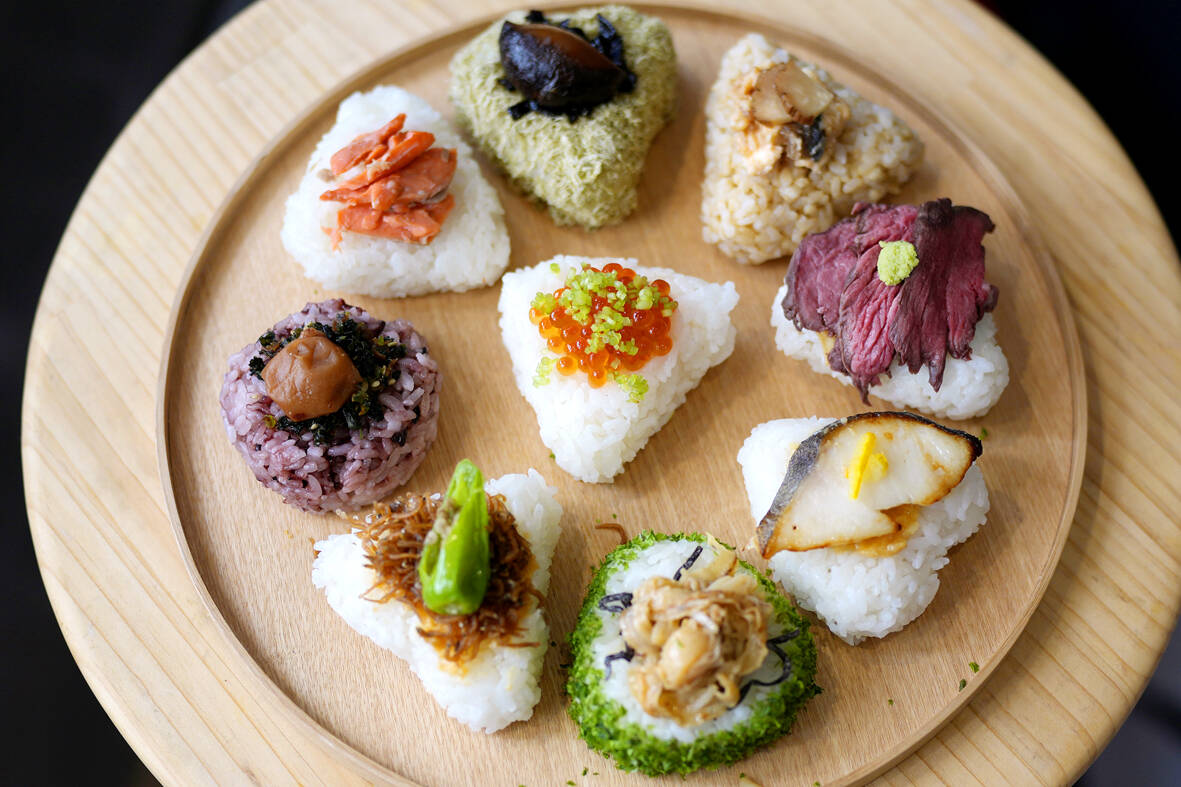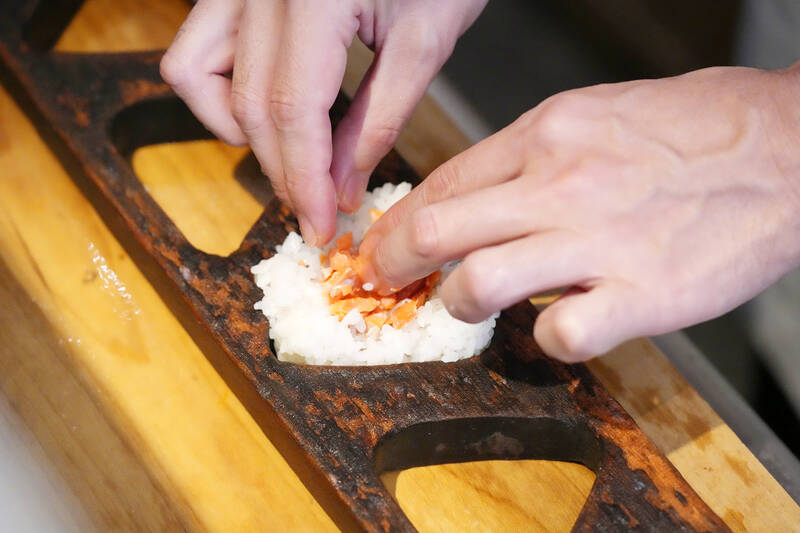It is barely 10am and the queue outside Onigiri Bongo already stretches around the block. Some of the 30 or so early-bird diners sit on stools, sipping green tea and poring over laminated menus. Further back it is standing-room only.
“It’s always like this,” says Yumiko Ukon, who has run this modest rice ball shop and restaurant in the Otsuka neighbourhood of Tokyo for almost half a century. “But we never run out of rice,” she adds, seated in her office near a wall clock in the shape of a rice ball with a bite taken out.
Bongo, opened in 1960 by Ukon’s drum-playing husband, sells as many as 1,500 rice balls a day. Its customers are a mixture of loyal locals, inquisitive diners from out of town and, increasingly, a foreign clientele eager to taste the inspiration for the global boom in onigiri — triangles of warm, lightly salted rice embellished with a topping or filling and, more often than not, wrapped in crisp nori seaweed.

Photo: AP
The queues outside Bongo are as legendary as its choice of 57 toppings, from the popular sujiko — salmon roe — and umeboshi plum to the more unconventional bacon and cheese, all accompanied by pickled cucumber and radish and a bowl of miso soup.
“The longest anyone has waited is eight hours,” says Ukon, 72. “Onigiri are so simple — rice, salt, seaweed and a topping — and anyone can make them. When you bring a smile to someone’s face with something as simple as that, it’s really special.”
At lunchtime, the diners waiting for a seat at Bongo’s counter include Keita Kimura, who is just minutes away from sampling its koshihikari rice from Ukon’s Niigata prefecture, enveloped in nori from the Ariake Sea.

Photo: AP
“I eat a lot of convenience store onigiri but I’ve never tried a speciality shop,” says the 27-year-old, adding that he has decided to order toppings of tuna and mayonnaise and deep-fried chicken. “The variety is a big attraction, and you can eat them quickly.”
RISING DEMAND
While rice sales in Japan are in decline, shortages notwithstanding, demand for onigiri is rising — a trend industry observers attribute to changing eating habits when the COVID-19 pandemic began, as people started ordering “artisanal” onigiri to take home for dinner.

Photo: AP
Wrapped triangular or circular rice balls have long been a staple of Japan’s ubiquitous convenience stores, where they are snapped up by office workers looking for something cheap and filling to tide them over until the evening.
Those stores, too, are riding the onigiri wave with new varieties and, at the FamilyMart chain, high-end versions made in collaboration with well-known restaurants feature fillings such as meuniere-style salmon and line-caught bluefin tuna with smoked pickled radish. The major konbini chain 7-Eleven, which started selling onigiri soon after it opened its first store in 1974, sold more than two billion rice balls in the year ending April last year, according to the Toyo Keizai online business magazine.
Now the humble dish is making its mark overseas, in Britain, Germany, Australia, the US and parts of Asia — a trend reflected in Japanese rice exports, which rose from 4,516 tonnes in 2014 to 28,928 tonnes in 2022, according to the agriculture ministry.
Mika Kazato, who runs the Japanese cafe Parami in Sydney’s Surry Hills, has been blown away by Australians’ enthusiasm for the dish.
“I didn’t expect it,” she says.
In 2022 her team started making just 50 onigiri each day but they now make up to 500, as customers flock to try the rice balls to accompany cups of coffee or matcha.
“It’s really yum, it’s like the perfect little amount for a snack,” says one customer, George.
But it is the French who have arguably done most to propel onigiri into the same culinary space as sushi and Japan’s other soul food, ramen. Paris is home to than 50 onigiri shops, rice balls are sold in many supermarkets and, this summer, the French judoka Luka Mkheidze credited them with giving him and his teammates that little extra required to win medals at the Paris Olympics.
“Onigiri are like fuel for the body,” he told the Asahi Shimbun, three years after he tried his first onigiri at the postponed Tokyo Games. “They give me energy so I can perform properly throughout the day.”
‘A REALLY FLEXIBLE DISH’
In the Tokyo neighborhood of Asakusa, Anastasia and Rame Bouslimi are among a glut of lunchtime customers outside Onigiri Yadoroku, the city’s oldest rice ball shop and, in 2018, the recipient of a Michelin Bib Gourmand rating, awarded to restaurants that serve inexpensive meals.
The couple have eaten onigiri in their native Germany but are eager to sample an early lunch at Yadoroku, which opened in 1954. “The onigiri in Japan are far, far better,” Anastasia says. “They’re cheap and good for you … like a healthy sandwich.”
Her husband says onigiri were the obvious choice for a late breakfast on their first full day in Japan.
“When you think of Germany you think of bread, when you think of Japan you think of onigiri. When we were considering what to eat, onigiri was the first thing that came to mind.”
The Japanese are thought to have been snacking on something resembling an onigiri — often referred to as omusubi in some parts of the country — since at least the early 11th century.
They appear in Murasaki Shikibu’s Heian period (794-1185) novel The Tale of Genji, and in the Hayao Miyazaki anime masterpiece Spirited Away, as well as in Utagawa Hiroshige’s 1830s ukiyo-e prints The Fifty-Three Stations of the Tokaido and Akira Kurosawa’s classic 1954 film Seven Samurai.
When Ukon’s late husband opened Bongo there were very few specialist shops and Japan’s first convenience store would not open for about another 10 years. For decades onigiri were considered a snack to be made and eaten at home, or as part of a bento for school sports days, picnics and long train journeys.
Yusuke Nakamura’s love of rice balls started as a young child.
“I didn’t have much of an appetite so my mother would make onigiri, put them down and tell me it didn’t matter if I ate them or not,” says Nakamura, the chair of the Onigiri Society, which organized the first onigiri summit this year and hopes the dish will feature prominently at next year’s World Expo in Osaka. “But, somehow, I always ate them and grew to love them.”
Nakamura, whose organization works with businesses to promote onigiri domestically and internationally, expects the dish to adapt as it continues to attract fans beyond Japan’s shores.
“It’s really flexible,” he says. “As long as it contains rice and a filling and can be eaten with one hand, you can call it an onigiri.”
There is, though, one non-negotiable rule, he says. “Whatever you do, do not sprinkle them with soy sauce.”

Jan. 6 to Jan. 12 Perhaps hoping to gain the blessing of the stone-age hunter-gatherers that dwelt along the east coast 30,000 years ago, visitors to the Baxian Caves (八仙洞) during the 1970s would grab a handful of soil to bring home. In January 1969, the nation was captivated by the excavation of pre-ceramic artifacts and other traces of human habitation in several caves atop a sea cliff in Taitung County. The majority of the unearthed objects were single-faced, unpolished flake tools fashioned from natural pebbles collected by the shore. While archaeologists had found plenty of neolithic (7,000 BC to 1,700

Famed Chinese demographer Yi Fuxian (易富賢) recently wrote for The Diplomat on the effects of a cross-strait war on demography. He contended that one way to deter the People’s Republic of China (PRC) is by putting the demographic issue front and center — last year total births in the PRC, he said, receded to levels not seen since 1762. Yi observes that Taiwan’s current fertility rate is already lower than Ukraine’s — a nation at war that is refusing to send its young into battle — and that its “demographic crisis suggests that Taiwan’s technological importance will rapidly decline, and

When the weather is too cold to enjoy the white beaches and blue waters of Pingtung County’s Kenting (墾丁), it’s the perfect time to head up into the hills and enjoy a different part of the national park. In the highlands above the bustling beach resorts, a simple set of trails treats visitors to lush forest, rocky peaks, billowing grassland and a spectacular bird’s-eye view of the coast. The rolling hills beyond Hengchun Township (恆春) in Pingtung County offer a two-hour through-hike of sweeping views from the mighty peak of Dajianshih Mountain (大尖石山) to Eluanbi Lighthouse (鵝鑾鼻燈塔) on the coast, or

Her greatest fear, dormant for decades, came rushing back in an instant: had she adopted and raised a kidnapped child? Peg Reif’s daughter, adopted from South Korea in the 1980s, had sent her a link to a documentary detailing how the system that made their family was rife with fraud: documents falsified, babies switched, children snatched off the street and sent abroad. Reif wept. She was among more than 120 who contacted The Associated Press this fall, after a series of stories and a documentary made with Frontline exposed how Korea created a baby pipeline, designed to ship children abroad as quickly as